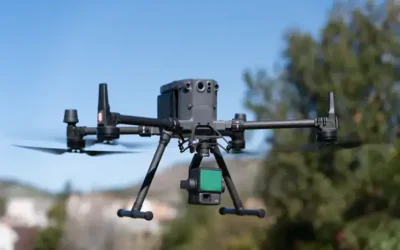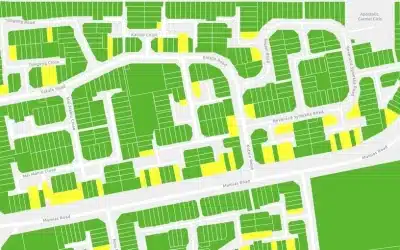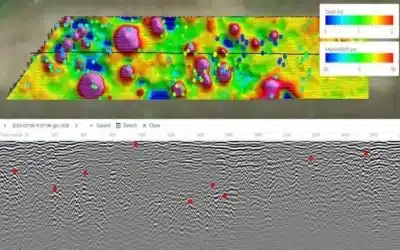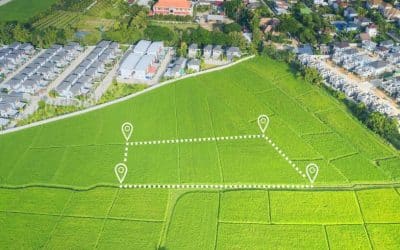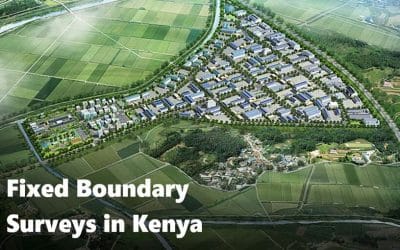DJI Matrice 300
The DJI Matrice 300 is a professional-grade quadcopter drone designed for industrial applications such as surveying, inspection, and search and rescue operations. It features an advanced flight control system, a long flight time, and a high payload capacity, making it a versatile and reliable tool for various industries.
Here are some of the key features of the DJI Matrice 300: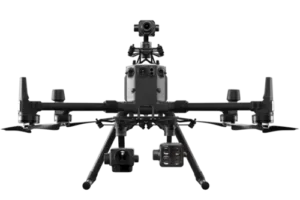
- Flight Control System: The DJI Matrice 300 features an advanced flight control system that includes multiple sensors, intelligent algorithms, and redundant systems. This allows the drone to fly smoothly and safely in a wide range of environments, even in challenging weather conditions.
- Flight Time: The DJI Matrice 300 has a maximum flight time of up to 55 minutes, which is longer than many other commercial drones on the market. This extended flight time allows for more efficient data collection and reduces the need for frequent battery changes.
- Payload Capacity: The DJI Matrice 300 has a maximum payload capacity of up to 2.7 kg, which is sufficient for carrying most surveying and inspection cameras and sensors. This allows for high-quality data collection and analysis, even in complex environments.
- Imaging Capabilities: The DJI Matrice 300 supports a range of imaging and mapping sensors, including the DJI Zenmuse P1 and L1 cameras, which provide high-resolution 3D mapping and point cloud data. The drone also supports thermal cameras for inspection and search and rescue operations.
- Safety Features: The DJI Matrice 300 features a range of safety features, including obstacle avoidance sensors, a redundant communication system, and a built-in ADS-B receiver for detecting nearby aircraft. These safety features help ensure that the drone can operate safely and effectively in a range of environments.
Overall, the DJI Matrice 300 is a reliable and versatile drone that is well-suited for a range of industrial applications. Its advanced flight control system, long flight time, and high payload capacity make it a powerful tool for data collection, inspection, and search and rescue operations.
WingtraOne
The WingtraOne is a professional-grade, fixed-wing drone designed for aerial mapping and surveying applications. Unlike most commercial drones that are quad-copters, the WingtraOne is a vertical takeoff and landing (VTOL) drone that combines the benefits of a fixed-wing drone and a multi-rotor in one aircraft. It offers several features that make it a reliable and efficient tool for aerial mapping and surveying.
Here are some of the key features of the WingtraOne:
- VTOL Capability: The WingtraOne’s VTOL capability allows it to take off and land vertically like a multi-rotor, but also fly horizontally l
 ike a fixed-wing drone. This makes it suitable for use in challenging terrain, such as mountains or forests, where takeoff and landing space is limited.
ike a fixed-wing drone. This makes it suitable for use in challenging terrain, such as mountains or forests, where takeoff and landing space is limited. - Flight Time: The WingtraOne has a maximum flight time of up to 59 minutes, which is longer than most quadcopter drones on the market. This allows for longer flights and greater coverage of areas, which can be particularly useful for large-scale mapping projects.
- Payload Capacity: The WingtraOne has a maximum payload capacity of up to 1.5 kg, which is sufficient for carrying high-end cameras and sensors such as LiDAR or photogrammetry cameras. This allows for high-quality data collection and analysis, even in complex environments.
- Imaging Capabilities: The WingtraOne supports a range of cameras and sensors, including RGB, multispectral, and thermal cameras, as well as LiDAR sensors. This allows for accurate 3D mapping and modeling of terrain, structures, and vegetation.
- Flight Planning and Control: The WingtraOne comes with a user-friendly software platform for mission planning and control. The software allows for automated takeoff and landing, as well as autonomous flight paths, which can be programmed to cover specific areas and altitudes.
The WingtraOne is a versatile and reliable drone that is well-suited for aerial mapping and surveying applications. Its VTOL capability, long flight time, and high payload capacity make it a powerful tool for data collection and analysis in challenging environments.
Comparison: DJI Matrice 300 vs. WingtraOne
The DJI Matrice 300 and WingtraOne are two popular commercial-grade drones used for aerial surveying, mapping, and inspection. Here are some of the key differences between the two drones:
- Flight Time: The DJI Matrice 300 has a maximum flight time of up to 55 minutes, while the WingtraOne has a maximum flight time of up to 59 minutes. This means that the WingtraOne can cover more area in a single flight, which can be an advantage in large-scale mapping projects.
- Payload Capacity: The DJI Matrice 300 has a maximum payload capacity of up to 2.7 kg, while the WingtraOne has a maximum payload capacity of up to 1.5 kg. This means that the DJI Matrice 300 can carry heavier sensors and cameras, which can be useful for high-end mapping and inspection applications.
- Flight Range: The DJI Matrice 300 has a maximum flight range of up to 15 km, while the WingtraOne has a maximum flight range of up to 50 km. This means that the WingtraOne can cover larger areas and fly farther from the operator, which can be useful in remote areas and for longer distance missions.
- Vertical Takeoff and Landing (VTOL): The WingtraOne is a VTOL drone, which means that it can take off and land vertically like a helicopter, but can also fly like a fixed-wing drone for longer distances. The DJI Matrice 300, on the other hand, is a quadcopter that can only take off and land vertically. This means that the WingtraOne can be used in more challenging terrain and environments, such as mountainous regions, while the DJI Matrice 300 is better suited for more straightforward missions.
- Price: The DJI Matrice 300 is generally less expensive than the WingtraOne, which can make it a more accessible option for smaller-scale projects. However, the WingtraOne’s longer flight range and VTOL capabilities may make it a better choice for more specialized applications such as large infrastructure projects.
In conclusion, the DJI Matrice 300 and WingtraOne have different capabilities and weaknesses, and the choice between them depends on the specific needs of your project. The DJI Matrice 300 is better suited for simpler missions that require a heavier payload, whilst the WingtraOne is more versatile and can cover larger areas and operate in more challenging terrain because of its capability in Vertical take-off and landing.





